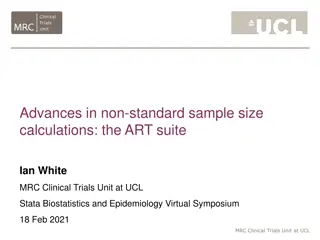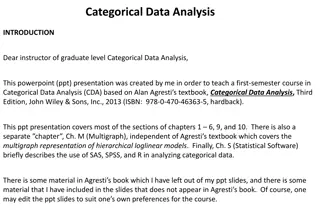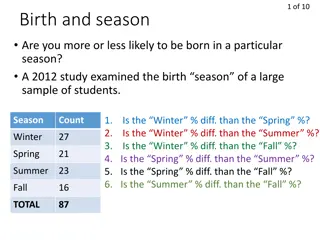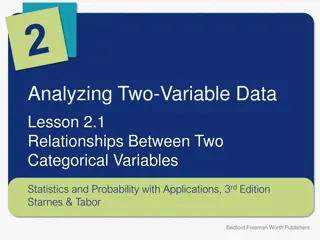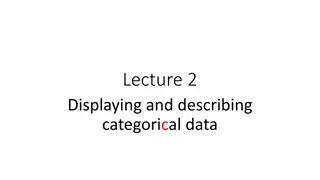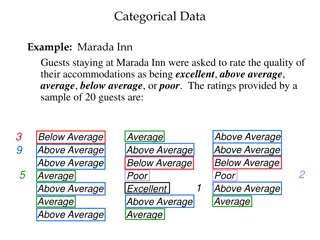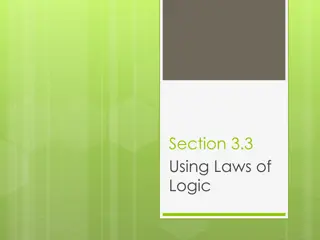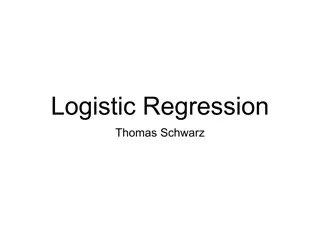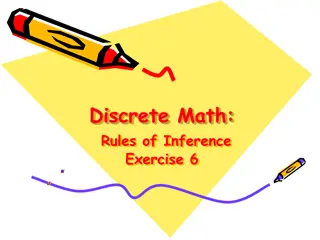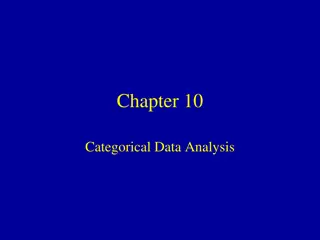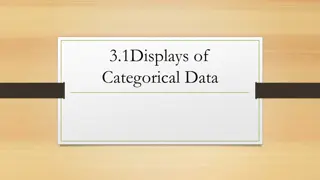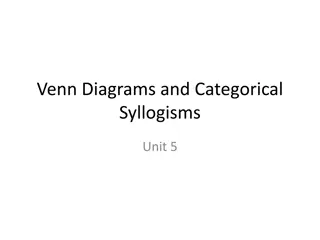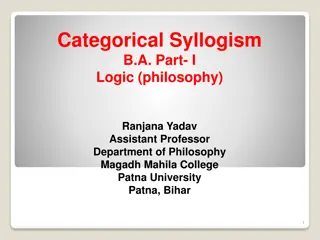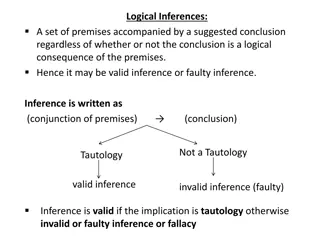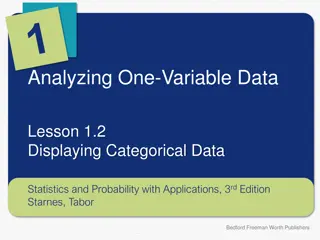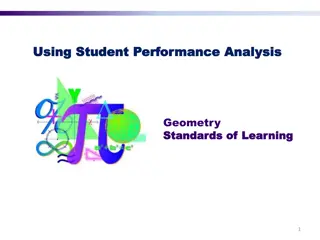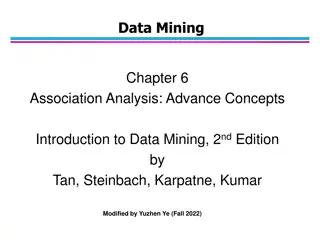Semi-Supervised Credit Card Fraud Detection via Attribute-Driven Graph Representation
Explore a novel approach for detecting credit card fraud using a semi-supervised attribute-driven graph representation. The technique leverages temporal aggregation and attention layers to automatically unify heterogeneous categorical attributes and detect fraudulent transactions without label leaka
1 views • 23 slides
School Parent Involvement Budgeting Guidelines 2015-2016
Providing guidance to schools on developing categorical budgets and aligning Title I parent involvement funds with program guidelines. Research shows parental involvement improves student outcomes. LAUSD's core beliefs, goals, and district goals emphasize student achievement, safety, and community e
6 views • 21 slides
Overview of Categorical Aid in Education Finance
Categorical aid in education funding serves specific purposes such as special education, transportation, and mental health. It operates outside revenue limits and often comes in fixed or prorated amounts. The process involves targeted grants and reimbursement formulas. Special Education & School-Age
1 views • 36 slides
Identifying Student Percentage Reporting SY 2021 - 2022
Identified Student Percentage Reporting (ISP) is essential for districts to report the number of students identified through direct certification and categorical lists in eSchool. This report must be submitted by April 15, 2022, to comply with federal regulations. Understanding how ISP is calculated
1 views • 12 slides
Advances in Sample Size Calculations for Clinical Trials: The ART Suite
This presentation discusses the importance of sample size calculations in research studies, especially in the context of clinical trials. It covers tools like ART and Power in Stata for binary and categorical outcomes, emphasizing the need to determine the right sample size to ensure research questi
4 views • 35 slides
Graduate Level Categorical Data Analysis Course
This PowerPoint presentation offers a comprehensive guide to teaching a first-semester course in Categorical Data Analysis at the graduate level. Covering key sections from Alan Agresti's textbook, the presentation includes real-data examples, software guidance, and solutions to exercises. The instr
1 views • 5 slides
Categorical and Numerical Data in Mathematics
Explore the distinction between categorical and numerical data in math. Learn how mathematicians categorize and analyze data, sorting cards into different categories to understand similarities and differences. Develop perseverance skills by determining survey question types and defining data types w
0 views • 9 slides
Programs and Services for Students with Disabilities at California Community Colleges
The Disabled Students Programs and Services (DSPS) at California Community Colleges provide a range of support services, specialized instruction, and accommodations for students with disabilities to ensure their full participation and equitable college experience. Services include test-taking facili
0 views • 8 slides
Deontology and Distributive Justice in Ethics
Deontology, rooted in the concept of duty, focuses on morally required, forbidden, or permitted choices. It emphasizes obedience to duty, opposing utilitarian claims. Unlike virtue theories, deontology prioritizes what is right over an overall conception of good. Immanuel Kant's categorical imperati
0 views • 32 slides
Introduction to Binary Logistic Regression: A Comprehensive Guide
Binary logistic regression is a valuable tool for studying relationships between categorical variables, such as disease presence, voting intentions, and Likert-scale responses. Unlike linear regression, binary logistic regression ensures predicted values lie between 0 and 1, making it suitable for m
7 views • 17 slides
Introduction to Multinomial Logistic Regression by Dr. Heini V. at University of Southampton
This content introduces Multinomial Logistic Regression, discussing categorical response variables, the basics of the model, interpretation of parameters, and an example study on economic activity and gender. It covers the extension of binary logistic regression to multiple categories, interpretatio
1 views • 16 slides
Statistical Analysis in Birth Season Distribution
A statistical study examines birth season distribution among students, comparing the number of births in different seasons. Chi-Square tests are utilized to analyze the data and test for associations between categorical variables. An example uses the goodness-of-fit test to determine if student grad
0 views • 10 slides
Analyzing Relationships Between Categorical Variables in Statistics
Explore relationships between two categorical variables in statistics, distinguishing between explanatory and response variables. Learn to create segmented bar charts and identify associations. Understand the importance of identifying explanatory variables in analyzing data relationships. Improve yo
1 views • 15 slides
Parallel Chi-square Test for Feature Selection in Categorical Data
The chi-square test is a popular method for feature selection in categorical data with classification labels. By calculating chi-square values in parallel for all features simultaneously, this approach provides a more efficient solution compared to serial computation. The process involves creating c
2 views • 4 slides
Efficient fMRI Experimental Design: Maximizing Neurovascular Response
Understanding the importance of correctly designing fMRI experiments is crucial for testing specific hypotheses by manipulating stimulus types, timing, and participant instructions. Types of experimental designs include categorical, factorial, and parametric designs, each serving different purposes
0 views • 35 slides
Visualizing Categorical Data in Data Analysis
Explore methods for displaying and describing categorical data effectively, from frequency tables to bar and pie charts. Understand the importance of visual representation in drawing insights and making comparisons. Dive into examples using football team data and Titanic survivors. Learn to identify
1 views • 20 slides
Alaska Department of Transportation NEPA Assignment Program Overview
The Alaska Department of Transportation's NEPA Assignment Program aims to assess and evaluate the environmental effects of actions through the National Environmental Policy Act (NEPA). Since 2009, the DOT&PF has been responsible for Categorical Exclusion determinations, ensuring compliance with envi
0 views • 19 slides
Analysis of Categorical Data at Marada Inn and Pelican Stores
The analysis includes rating frequencies and relative frequencies for quality ratings at Marada Inn, as well as customer transaction data at Pelican Stores during a promotion. Graphs and tables summarize qualitative variables for evaluation and managerial reporting.
0 views • 28 slides
Analyzing Categorical Growth and Values Table in Accountability Panel
Analyze the growth and values table in the accountability panel through categorical growth and status improvement tables. The subgroups' significance of categorical status changes is assessed using a rating system. Temporary cut scores for sub-categories have been employed for evaluation, with a foc
0 views • 51 slides
Chi-Square Tests in Statistics
Chi-square tests in statistics are used to examine the relationship between categorical variables or test claims about categorical variable distributions in populations. The Chi-square test statistic measures the discrepancy between observed and expected counts, with the Chi-square distribution help
0 views • 16 slides
Parallel Implementations of Chi-Square Test for Feature Selection
The chi-square test is an effective method for feature selection with categorical data and classification labels. It helps rank features based on their chi-square values or p-values, indicating importance. Parallel processing techniques, such as GPU implementation in CUDA, can significantly speed up
0 views • 4 slides
Laws of Logic and Logical Reasoning
Laws of logic play a crucial role in reasoning and making deductions. This comprehensive guide explains the use of contrapositives, examples of conditional statements, and the significance of laws like the Law of Syllogism. Understanding these principles helps in effectively analyzing statements and
0 views • 8 slides
Binary Outcome Prediction Models in Data Science
Categorical data outcomes often involve binary decisions, such as re-election of a president or customer satisfaction. Prediction models like logistic regression and Bayes classifier are used to make accurate predictions based on categorical and numerical features. Regression models, both discrimina
0 views • 67 slides
Rules of Inference Exercises and Solutions in Discrete Mathematics
Explore exercises and solutions in discrete mathematics focusing on rules of inference. Analyze logical premises and draw relevant conclusions using rules such as modus tollens, modus ponens, and disjunctive syllogism. Understand the application of these rules in different scenarios to reach valid d
0 views • 4 slides
Multidimensional Icons in Data Visualization Solutions
This collection showcases various types of visual icons used in data visualization to represent values of different variables, such as categorical, quantitative, and Boolean data. Each icon summarizes specific information for a given item in a collection, ranging from nominal and ordinal data to the
0 views • 9 slides
Enhancing Restoration Efforts in Western Oregon
Exploring examples from Western Oregon where authorities are maximizing restoration efforts by utilizing environmental assessments, impact statements, and categorical exclusions. Smart practices, gaps filling, and the significant impacts of these efforts on timber harvesting and revenue generation i
0 views • 13 slides
Environmental Review Requirements for Residential Care Facilities
This document discusses the environmental review requirements for residential care facilities as per the U.S. Department of Housing and Urban Development. It covers topics such as environmental assessments, categorical exclusions, causes of common delays, and the timing of Phase I ESA. Understanding
0 views • 44 slides
Categorical Data Analysis for Proportion Estimation
In the realm of categorical data analysis, estimating proportions is crucial for understanding population characteristics. This involves sampling, calculating sample proportions, standard errors, and constructing confidence intervals. Through examples like studying the effects of treatments on medic
0 views • 72 slides
Categorical Data Analysis in Population Studies
Inference methods for estimating proportions in a population are essential in categorical data analysis. This includes techniques for single proportions, confidence intervals, sample size determination, and Wilson-Agresti-Coull method for small sample sizes. Illustrated with examples and visuals, th
0 views • 80 slides
Budget Overview for Chairs Council Meeting
This budget overview presentation provides a detailed breakdown of the funds allocated to different categories, including the General Fund, Categorical grants, and Pots of funds. It highlights the distribution of funds towards salaries, benefits, discretionary spending, and various educational initi
0 views • 5 slides
Categorical Data Displays and Analysis
Visual displays of categorical data such as bar graphs, pie charts, and frequency distributions help organize and interpret large amounts of data effectively. Different types of graphs serve specific purposes, like comparing categories visually and identifying modes easily. This overview covers the
0 views • 10 slides
Exploring the Philosophy of Immanuel Kant
Delve into the profound philosophical works of Immanuel Kant, focusing on Kantian epistemology, the nature of judgments, synthetic a priori judgments, enlightenment, morality through the Categorical Imperative, and political theories advocating for perpetual peace. Kant's ideas challenge traditional
0 views • 8 slides
Statistical Analysis Practice Questions with Solutions
Practice various statistical analysis concepts including categorical and quantitative variables, mean calculations, distribution summaries, ogive interpretation, and data display techniques through a series of questions and images. Enhance your statistical knowledge and problem-solving skills with t
0 views • 20 slides
Mites and Wilt Disease: Simulation in a 2x2 Table
Researchers investigate the impact of spider mite infestation on plant resistance to Wilt disease using a randomized experiment. A physical simulation involving cards helps students explore the relationship between categorical variables, risk calculation, and prediction making in an introductory sta
0 views • 19 slides
Venn Diagrams and Categorical Syllogisms
Venn diagrams, introduced by John Venn, visually represent relationships between different classes. Shading in diagrams signifies empty sets or no overlap between classes. Different types of categorical statements such as universal and particular are illustrated using examples. Explore how Venn diag
0 views • 30 slides
Categorical Syllogism in Logic: A Comprehensive Overview
Categorical syllogism, a form of inference with two premises and a conclusion, is a fundamental concept in logic. This type of deductive argument consists of three categorical propositions - universal affirmative, universal negative, particular affirmative, and particular negative. Terms such as maj
0 views • 16 slides
Logical Inferences and Rules of Inference
Logical inferences involve drawing conclusions from premises, which can either be valid or invalid based on the rules of inference. This includes Modus Ponens, Hypothetical Syllogism, DeMorgan's Law, and Law of Contrapositive. Invalid inferences result in fallacies like denying the antecedent. Exerc
0 views • 18 slides
Displaying Categorical Data: Bar and Pie Charts
This lesson explores the visual representation of categorical data using bar and pie charts. Learn how to create and interpret these graphs to display variable distributions clearly. Understand deceptive graph practices and master the skills to make accurate and informative data displays in Statisti
0 views • 16 slides
Geometry Standards of Learning Practice Problems
Explore practice problems related to Geometry Standards of Learning (SOL), covering topics such as symbolic representation of arguments, laws of detachment, contrapositive, syllogism, counterexamples, and geometric proofs. Test your understanding of angles, lines, transversals, and congruence to str
0 views • 50 slides
Advanced Concepts in Association Analysis: Handling Categorical Attributes
Explore advanced concepts in association analysis, focusing on the handling of categorical attributes. Learn how to apply association analysis to non-asymmetric binary variables, including examples and potential solutions for skewed attribute value distributions. Discover techniques for managing att
0 views • 48 slides




